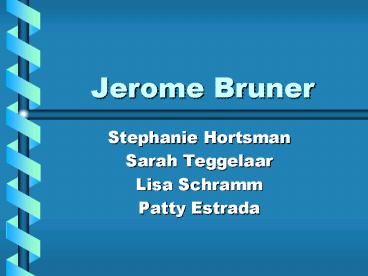Jerome Bruner - PowerPoint PPT Presentation
1 / 18
Title:
Jerome Bruner
Description:
Diagram. Chart. Graph. POWER POINT !!! Symbolic Stage. Knowledge = words or ... Criteria: 4 wheels, transportation, engine. Categories: Car & Truck (etc. ... – PowerPoint PPT presentation
Number of Views:832
Avg rating:3.0/5.0
Title: Jerome Bruner
1
Jerome Bruner
- Stephanie Hortsman
- Sarah Teggelaar
- Lisa Schramm
- Patty Estrada
2
Who was Jerome Bruner?
- Born in NYC 1915
- Duke University
- Harvard (Ph.D. in 1947)
- Social psychologist
- Professor of psychology at Harvard
- Work on ways in which needs, motivations, and
expectations influence perception - 1950s- took and interest in U.S. schools
- The Process of Education in 1960
- 1963- Distinguished Scientific Award from the
American Psychological Association - 1965- served as president of the association
3
MACOS Project(Man A Course of Study)
- What is uniquely human about human beings?
- How did they get that way?
- How could they be made more so?
4
Contrasting Constructivist and Objectivist
Theories
- Constructivist
- Learning is constructed knowledge.
- Students participate generate knowledge.
- Humans construct knowledge by participation.
- Directed instruction is too rigid
teacher-centered.
- Objectivist
- Learning is transmitted knowledge.
- Teaching is teacher-directed, systematic, and
structured. - Knowledge is outside of the human mind. Learning
occurs when people absorb store it. - Constructivism lacks structure.
5
Principles of Constructionism
- Instruction must be concerned with the
experiences and contexts that make the student
willing and able to learn. - Readiness
- Instruction must be structured so that it can be
easily grasped by the student. - Spiral Organization
- Instruction should be designed to facilitate
extrapolation and/ or fill in the gaps. - Going beyond given info.
6
Readiness
- Any child can learn the subject matter if it is
converted into a form ( stage) appropriate to
that child - Cant teach Could teach
- astrophysics gravity
- to a two-year-old
7
SpiralOrganization
- Repetition could be key
- Keep going in a circle
- Different cultures
- different ways
- Different reasoning
- Different inference
8
Discovery Learning
- Enactive Stage
- Iconic Stage
- Symbolic Stage
- Not Age-Dependent or Invariant
9
Enactive Stage
- Knowledge motor response
- You are doing something
- Kinesthetic
- Psychomotor
- Not limited to children
- Difficult to put in words/pictures
10
Iconic Stage
- Knowledge visual pictures
- You see something
- Diagram
- Chart
- Graph
- POWER POINT !!!
11
Symbolic Stage
- Knowledge words or symbols
- Not icons
- Symbols are random
- Not necessarily or always logical
12
Categorization
- Perception
- Conceptualization
- Learning
- Decision making
- Making inferences
- all involved categorization
13
Categories are "rules" that specify
- Criterial attributes - required characteristics
for inclusion of an object in a category - The second rule prescribes how the criteral
attributes are combined. - The third rule assignees weight to various
properties. - The fourth rule sets acceptance limits on
attributes. Some attributes can vary widely.
Others are fixed.
14
Kinds of Categories
- Identity categories - categories include objects
based on their attributes or features. - Equivalent categories provide rules for combining
categories. - Equivalence can be determined by affective
criteria, which render objects equivalent by
emotional reactions, functional criteria, based
on related functions or by formal criteria. - Coding systems are categories serve to recognize
sensory input. - They are major organizational variables in higher
cognitive functioning. Going beyond immediate
sensory data involves making inferences on the
basis of related categories. Related categories
form a "coding system." These are hierarchical
arrangements of related categories.
15
Identity Categories
- Sample Category Cars
- Criteria 4 wheels
- transportation
- engine
16
Equivalent Categories
- Criteria 4 wheels
- transportation
- engine
- Criteria 4 wheels
- transportation
- engine
Category Car
Category Truck
17
Coding Systems
Criteria 4 wheels, transportation, engine
Categories Car Truck (etc.)
Coding System Motor Vehicles
18
Finally, Bruner concluded
- Application
- four characteristics of
- effective instruction
- Personalized willingness to learn ?
- Content Structure structured so it is easily
grasped by the learner - Sequencing what order?
- Reinforcement rewards and punishment































